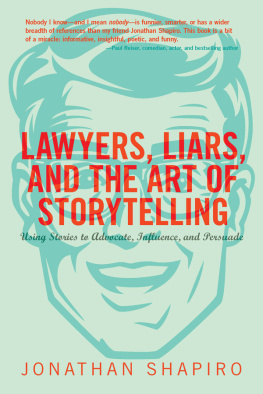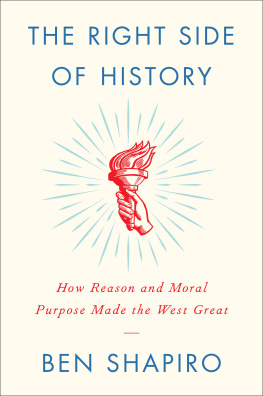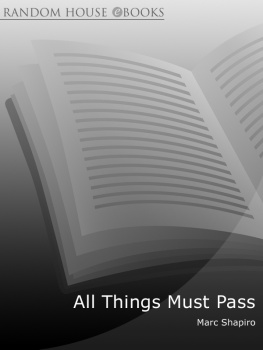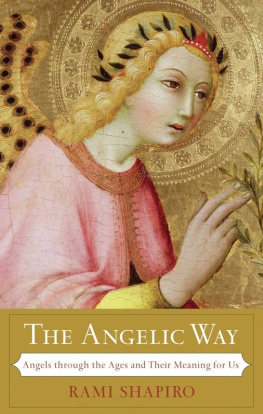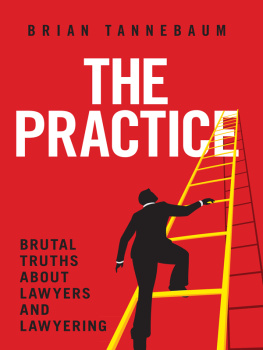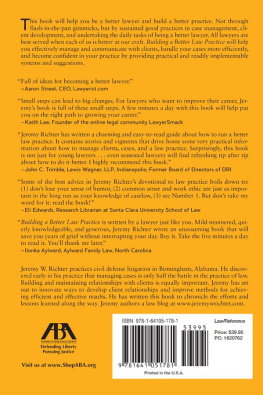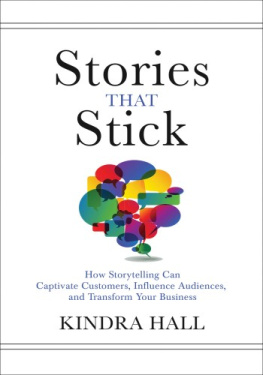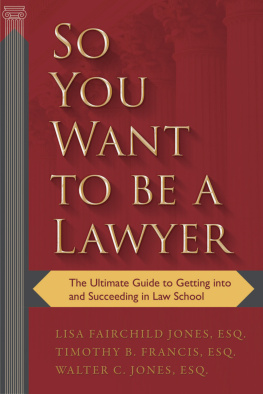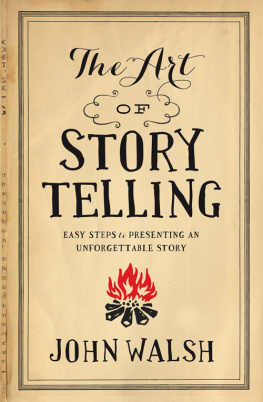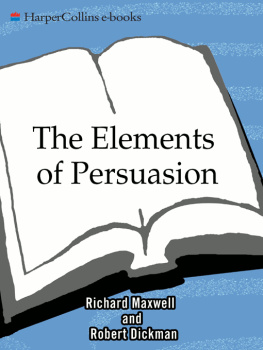Praise for Lawyers, Liars, and the Art of Storytelling
Jonathan Shapiros Lawyers, Liars, and the Art of Storytelling is so intriguing and witty that for a while I was certain I had written it.
Alan Zweibel, original Saturday Night Live writer and Thurber Prize winner for his novel The Other Shulman
Storytellingthe art of connecting with, captivating, and persuading ones listenersis the key to courtroom success. For the new generation of lawyers raised on texting, tweeting, and e-mailing, the art of old-fashioned storytelling has proven elusive, as those who can truly teach this ancient art form are fast disappearing. Thankfully, here comes Jonathan Shapiroone of Americas greatest trial lawyers and storytellersto the rescue.
Steve Zipperstein, General Counsel, Blackberry
Jonathan Shapiro is a terrific writer: incisive, informative, entertaining, and always engaging.
Erwin Chemerinsky, U.S. constitutional law and federal civil procedure scholar and current and founding dean of the University of California, Irvine School of Law
Lawyers, Liars, and the Art of Storytelling is a masterful book about storytelling by the master himself. Shapiro reveals the rewards of storytelling in the real and fictional legal worlds. Most importantly, he divulges the secrets to being a successful storyteller. It is a fun and interesting read for lawyers and non-lawyers alike.
Laurie L. Levenson, professor of law and David W. Burcham Chair of Ethical Advocacy, Loyola Law School, California
This is an important read for anyone who appreciates telling or hearing good stories, which should include anyone who cares a fig about the art of human communication. Thinking of this book as simply a how to guide for trial lawyers is as misguided as thinking of Norman McLeans classics as field manuals for anyone who plans to do some firefighting or trout fishing in Montana.
Ralph Alldredge, president of the California Newspaper Publishers Association and California Magazine Trial Lawyer of the Year
The art of advocacy is the art of taking the truth and fashioning it into a compelling story. No one does this better than Jonathan Shapiro. Shapiro jumps from story to story so quickly that you dont realize how much youve learned until the book ends.
The Honorable Jeffrey Bleich, U.S. Ambassador to Australia
If Jonathan did not exist, one might have to invent him in order to have this book written correctly.
from the Foreword by Robert C. Berring, Walter Perry Johnson Professor of Law, Berkeley Law School
LAWYERS, LIARS, AND THE ART OF STORYTELLING
LAWYERS, LIARS, AND THE ART OF STORYTELLING
Using Stories to Advocate, Influence, and Persuade
JONATHAN SHAPIRO
Write stories for those you love. It makes you try harder.
This book is written for my fellow lawyers, writers, and storytellers. My wife Betsy is a writer, my brother David is a lawyer, and all my closest friends seem to be one or the other. Now my childrenAbraham, Sarah, and Ezekielare becoming writers and storytellers in their own right.
This book is dedicated to all of them.
Foreword the First
Humanitys legacy of stories and storytelling is the most precious we have. All wisdom is in our stories and songs. A story is how we construct our experiences. At the very simplest, it can be: He/she was born, lived, died. Probably that is the template of our storiesa beginning, middle, and end. This structure is in our minds.
Doris Lessing
Come and listen to my story about a man named Jed, a poor mountaineer barely kept his family fed.
Telling stories is as natural to human beings as breathing. Thousands of years ago, storytellers provided entertainment just as they do today, but they also passed on the cultural heritage of civilization. Recorded as epic poems or stylized ballads, stories told of heroes, villains and gods. Religions and national epics are limned by stories. The development of the printing press and movable type replaced the centrality of the storyteller as recorder of events, but it never removed her from the collective consciousness. Storytelling carries on in each newly developed form of media. Books, television, movies, and now the pervasive blasts of creativity on the Internet are all elaborations on the telling of a story. Even the rarefied atmosphere of academia is currently fixated on the use of the story as a conveyor of information. What is the difference, after all, between data and understanding? It is the ability to put the data into a comprehensible package, something about which a person can make sense. Political regimes understand this fact.
Many governments labor mightily to control stories, to control the narrative. Holding the power to tell the story, to indicate the forces of good and the forces of evil, to explain what really happened in Tiananmen Square, or in the Ukraine or in Viet Nam, is vital. Planning a trip to the Balkans, one discovers competing stories, historic accounts that tell stories relating totally opposite facts. The winners write the final version of the tale; it is when competing entities survive that the competing sagas remain.
Yet storytelling often is not taken seriously. Children do it. Charlatans live by it. Popular culture is littered with con men and sharp characters who manipulate and deceive. Lawyers who pride themselves on technical skill are especially suspicious of honoring the storyteller. Stories lack rigor, stories are malleable. The charm of the teller may empower a foolish story just as the lack of grace of a teller can undermine a truthful one. What else explains the American legal systems distrust of juries? Why else have the systems elaborate rules of evidence that narrow how the story can be told in court? Storytellers can transport us, make us laugh and cry, make us learn and understand. Perhaps the power of the storyteller is too much.
When I began the study of law as a first-year student, the edited judicial opinion in the casebook drove me to distraction. A fascinating story might be set up: a young man whose hand was transformed into a hideous hairy appendage sues his doctor who had guaranteed a fully functional hand. Here was drama, a compelling story, absurd but enthralling, it pulled me in. But the story veered off into abstraction in the opinion. The reader learned about the use of the expectation measure in contract damages, but what happened to the boy with the hairy hand? If pressed, a professor would deflect the question. The end of the story does not matter. Oliver Wendell Holmes Jr. long ago opined that while a woman might care who the plaintiff was or if she was wearing a hat, the law cared nothing for such human details. The law is cold and hard-edged. Focus on the question of contract damages. The first year of law school is designed to bleach away the stories.
Jonathan Shapiro gives us the stories back. He demonstrates the power of storytelling and its inevitable importance. More important, he offers advice on how to do it well. Running at the subject from a variety of directions, he moves storytelling to center stage. If Jonathan did not exist, one might have to invent him in order to have this book written correctly. He is buried in stories. A journalist before coming to law school, Jonathan never stopped telling stories. Nor did he renounce the power of telling a good story. Years as an Assistant United States Attorney, a lawyer in private practice, a journalist, and a screen writer have immersed him in the power of the narrative. This unique background produces a book that ranges from the three pillars of Aristotle to remembrances of Professor David Daube to the theories of Professor Erving Goffman to David E. Kelly and Harvey Weinstein, with many stops in between. The author shows the reader how to tell stories by telling stories. Fortunately, he has some great stories to tell.

